 |
330 GT Registry |
 |

 |
FERRARI 330 GT |
| ← (This isn’t it) | |
|
WHEN YOU GET THAT FERRARI FEELING . . . |
No-one's ever said that the Ferrari is the best car in the world. Least of all,
Ferrari have never said it. They just rely on producing a superbly-engineered
machine—a sort of motoring watch, if you like—which keeps on winning motor-races
and attracting the attention of Those Who Know, and leave the rest to your
imagination. If you happen to have the odd million pounds to spare and you want
to spend it on big-time motor-racing, it isn’t just winning that you have to
concentrate on when it comes to the classic sports car and Grand Touring
events—the first thing to do is to beat the Ferrari, and after that winning’s
easy. Some how, the Ferrari—any modern Ferrari (because some of the older ones
don’t quite measure up to their reputation)—is simply right. It is right in all
respects—it looks right, sounds right, and as for the manner of its going,
right” is such a tiny word. To sit as a mere passenger in a Ferrari is a
motoring experience to tell your grandchildren: to drive one is probably what
it’s like in heaven; to own one, well—the thought leaves us speechless.
So far as this country is concerned, THE people for Ferrari are Maranello Concessionaires, who sell them, service them and, of course, race ‘em as well. So since logic is very occasionally our strong point, we hied ourselves down to Maranello Concessionaires as aforesaid one soaking afternoon in Britain’s spring to look closely at six-and-a-half-thousand-quid’s worth of Ferrari 330 G.T. We might describe this car as a symphony in steel, but we won’t, so don’t stop reading. One of the reasons why we won’t is that we are supposed to be a serious (well, fairly serious) motoring paper, and another is that we don’t go in for that sort of thing. But it’s very difficult to find a more common-sense way of describing it: it just strikes you that way.
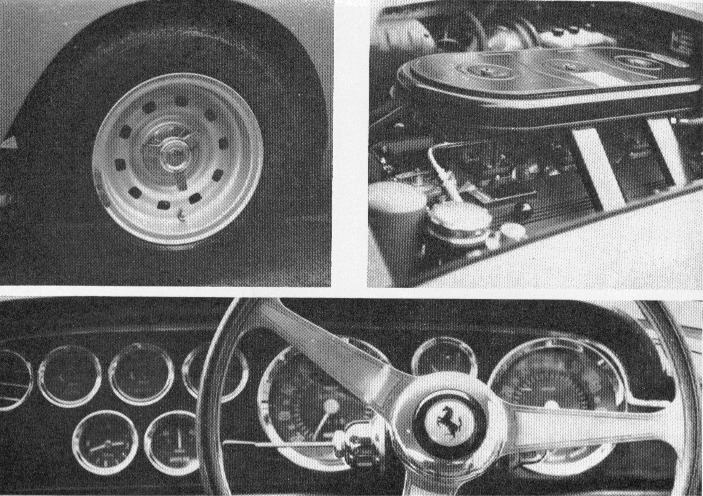 |
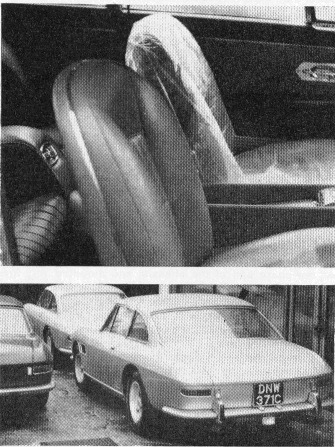 Since
Ferraris aren’t the sort of thing you find parked outside every suburban
semi-detached we may as well go into a certain amount of detail about the car
before we get altogether lyrical and wander off to play a harp, or write poetry,
or something. The basis of the whole thing is a stiff tubular chassis-frame made
of good sound steel, with plenty of sensible design, as much stiffness as you
can build in and no fancy gimmicks. The Ferrari people are strong followers of
the school of thought that says once a thing is right there is no point in
changing it unless it's for something better, and since there isn’t anything
much better than the end result of the Ferrari design . . . You take it from
there. Front suspension is independent, with wishbones, coil springs, an
anti-roll bar and telescopic dampers; the rear end is not, and you find a rigid
rear axle with fore and aft location arms, sprung on semi-elliptic leaf springs
AND coil-spring damper units, just to be on the safe side. The axle is of
limited-slip type, and the whole thing bears out the fact that a properly
designed and located rigid rear axle can transmit three hundred horse power to a
sloshing wet road as effectively as the fanciest i.r.s. arrangement—provided it
is done properly. On the Ferrari, it is. The wheels on the 330 G.T. are
mag.-alloy discs, of Ferrari manufacture, although you can have Borrani wire
ones, or wire Dunlops, if you wish. On the wheels are nice fat tyres—Pirelli
Cinturatos on the 330 G.T., which has fifteen-inch rims: the Berlinetta uses 14
inch wheels and is fitted with SPs. The wheelbase is 104+ inches, the rear
track, at 55 inches, is a little less than half-an-inch narrower than the front.
Stopping is taken care of by servo-assisted Dunlop discs on all four wheels.
Since
Ferraris aren’t the sort of thing you find parked outside every suburban
semi-detached we may as well go into a certain amount of detail about the car
before we get altogether lyrical and wander off to play a harp, or write poetry,
or something. The basis of the whole thing is a stiff tubular chassis-frame made
of good sound steel, with plenty of sensible design, as much stiffness as you
can build in and no fancy gimmicks. The Ferrari people are strong followers of
the school of thought that says once a thing is right there is no point in
changing it unless it's for something better, and since there isn’t anything
much better than the end result of the Ferrari design . . . You take it from
there. Front suspension is independent, with wishbones, coil springs, an
anti-roll bar and telescopic dampers; the rear end is not, and you find a rigid
rear axle with fore and aft location arms, sprung on semi-elliptic leaf springs
AND coil-spring damper units, just to be on the safe side. The axle is of
limited-slip type, and the whole thing bears out the fact that a properly
designed and located rigid rear axle can transmit three hundred horse power to a
sloshing wet road as effectively as the fanciest i.r.s. arrangement—provided it
is done properly. On the Ferrari, it is. The wheels on the 330 G.T. are
mag.-alloy discs, of Ferrari manufacture, although you can have Borrani wire
ones, or wire Dunlops, if you wish. On the wheels are nice fat tyres—Pirelli
Cinturatos on the 330 G.T., which has fifteen-inch rims: the Berlinetta uses 14
inch wheels and is fitted with SPs. The wheelbase is 104+ inches, the rear
track, at 55 inches, is a little less than half-an-inch narrower than the front.
Stopping is taken care of by servo-assisted Dunlop discs on all four wheels.
At the sharp end of the chassis, and mounted very low down, is one of the most famous and successful engines ever produced—the sixty-degree V12. Bore and stroke on the 330 G.T. are 77 mm. x 71 mm., and the total capacity is 3,9474 c.c.: with a moderate compression ratio of 8.8 to 1, maximum power is 300 b.h.p., and this you get at six-eight. Both crankcase and cylinder block are of cast alloy, with shrunk-in liners: the crankshaft runs in seven main bearings and the con-rods are coupled in pairs. The heads have hemispherical combustion chambers, and the inclined overhead valves are operated by single camshafts and roller-followers on the rockers: the camshafts are chain driven. There are three twin-choke Weber carburettors, twin coils and distributors and twin oil filters: the fuel feed to the carbs. is controlled by a mechanical pump when under way, so to speak, but you ‘prime” the system in the morning, or after the car has been standing for some time, by means of an electric pump controlled by a dashboard switch. Cooling is taken care of by the usual radiator and water-pump, but the only fan is an electric one, mounted in front of the radiator and operated thermostatically. An alternator supplies all the necessary current.
In the transmission department there is a single-dry-plate clutch of diaphragm type which mates the engine (as we say in the trade) to a five-speed gearbox. Synchromesh on all the forward gears, naturally, and direct gear is the fourth cog: fifth is an overdrive, although to all practical intents and purposes you use it on the road as a normal top gear. The ratios are what you would call close: to be exact, bottom is 2.536 to 1, second is 1.7, third 1.2, fourth 1 to 1 and fifth 0.72, so that the progression is close to the ideal. The final drive ratio is 4.25, which gives you about 17.3 m.p.h. per thousand r.p.m. in the direct fourth and about five miles an hour more in fifth.
The body is by Pininfarina and is as ideally suited to this type of car as an eggshell is to an egg. The 330 G.T. isn’t a small car—it’s overall length is 15 ft. 7 ins., and it weighs 27 cwt. dry—but when it stands by the side of the road it looks small. It also looks as though all you have to do is to unlock its chains and it will be off up the road before you’ve even got the engine started, a happy sort of eager look which the Italians in general and Mr. Farina in particular are particularly good at. The outline, despite all sorts of exciting-looking louvers behind the wheel-arches and so on, is completely smooth: the screen rakes very sharply, the hefty tyres fit snugly into the body and you don’t need to look at the prancing horse to know that this is something pretty special.
Inside the 330 G.T. is more than just
plain civilised—it’s downright luxurious. You can tell the sort of background
the car has by the way the seats are nearly perfect, all the controls and
instruments are exactly where you’d expect to find them, and by the way everyone
sits right down inside the car, which all helps a very low centre of gravity. It
is, of course, a two-door job, and is designated 2+2. But in fact the access to
the back seats is easy even for the tight-skirt brigade, and leg-room and
headroom was comfortable even for our tame six-footer. Admittedly, he said he
wouldn’t want to go to Glasgow in the back, but then we can’t think of anything
he would want to go to Glasgow in the back of. So there.
Once in, you make the necessary adjustments to the seat. It goes backwards and
forwards over a generous range, and the backrest, we need hardly say, is also
adjustable. Once comfy, the driver can then, as they say, take stock. In front
of him are two dirty great dials which record miles, and still more miles, an
hour—up to 180, to be exact—and revs up to 8,000, with a red line at seven. Oil
temperature and pressure gauges are up there where you can see ‘em, too, and
then in the middle of the dashboard are an ammeter, water temperature and petrol
gauges (the tank holds twenty gallons, so think before you say Fillerup”) and a
clock. Various knobs and switches control all the usual things plus the
rear-window demisting arrangements (a Triplex heated screen) and separate
heating and demisting systems for driver and passenger. The steering wheel is
big and wood-rimmed, and the gearlever is big, stout and purposeful.
Before you start up the works you can switch on your electric pump and prime the fuel system. Then start up on the key, and in passing we can say that this isn’t a mass-produced heap: it’s a race-bred piece of engineering—in fact, it’s what the pundits (whoever they are) had in mind when they coined the word “thoroughbred’, and it likes to be treated as such. So warm the engine up nicely first. Then poke her into first and go. There’s nothing fierce about it, and you find out just how docile and flexible it is in the first bit of heavy traffic: you can trickle along at six hundred r.p.m. in fifth gear and still accelerate cleanly and smoothly, although with a gearbox like that it is hard to think why anyone should ever want to. But as a demonstration of tractability it is pretty impressive, to say the least. As you accelerate and the revs go up to about two thousand you start to hear that beautiful Ferrari twelve-cylinder noise as it squirts out through four fat tail pipes. There isn’t much else to hear, in fact: the engine is either almost totally silent mechanically or else the sound damping is fool-proof, and we suspect that it is, to coin a phrase, six of one and half-a-dozen of the other.
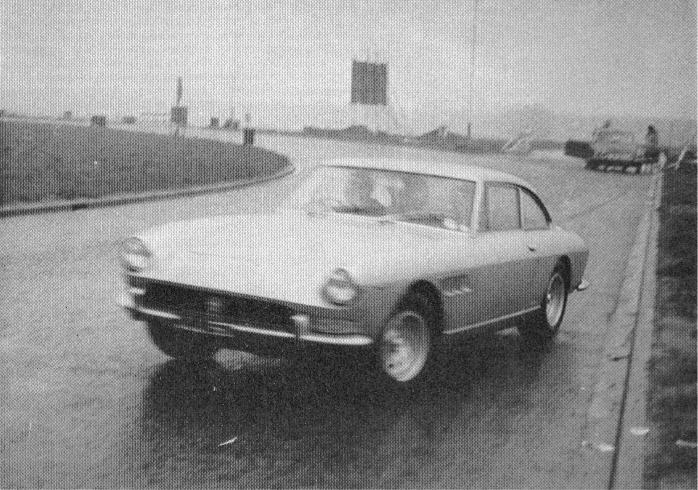
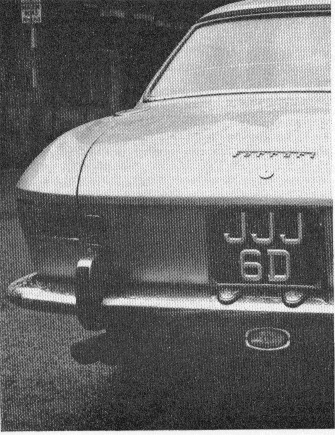 Even
with the rain sloshing down as it was during our run (which was too short by
about twenty thousand miles, we may say) traction was faultless. The Ferrari 330
G.T. just doesn’t do anything vulgar like spinning its wheels: the object of the
exercise is to translate 300 horsepower into forward motion, and it quietly gets
on with the job.
Even
with the rain sloshing down as it was during our run (which was too short by
about twenty thousand miles, we may say) traction was faultless. The Ferrari 330
G.T. just doesn’t do anything vulgar like spinning its wheels: the object of the
exercise is to translate 300 horsepower into forward motion, and it quietly gets
on with the job.
A couple of paragraphs earlier on we said “as you accelerate”. We meant what we said. We had no chance to take any sort of performance figures, but by going up to seven thousand in the gears you get 58 mph. in bottom gear, 85 in second, 110 in third, 135 in fourth and the top whack is said to be around 160 m.p.h. You can get from a standstill to the ton in round about thirteen seconds this way, and at high speed the car lollops along in comparative silence, easily and effortlessly. Mrs. Castle ought to have a ride in a car like this—it would give her food for thought about that b****y speed limit. But since its here we might as well say that the legal seventy leaves you with over four thousand revs in hand, and there is no real indication that you are moving except, in our case, the fact that the rain hit the screen that much harder than before. Nevertheless, the two-speed wipers looked after things very nicely. It’s marvellous how a Ferrari coming up astern gets people moving over out of the fast lane—even peasants scoot off out of it sharpish, and although the headlamp flasher occasionally came into play there was little opportunity to sound off those delightfully arrogant air horns.
The ride is firm, and at moderate speeds—say around seventy to eighty—there is a fair amount of road rumble, which intrudes all the more noticeably because of the quietness of everything else. Even at well over the ton there is no mechanical noise, and the only real sound you hear (apart from the gasps of admiration from passengers) is the delightful one of exhaust gases leaving twelve cylinders and four tail-pipes at high speed. There’s something about the noise of a Ferrari which even beats the look of the car, and the man at Maranello who designed the sound ought to be given a state pension. Except that if he was he might retire, or something, and then we might not hear it any more.
As the speed increases the ride smoothes out quite noticeably, and you then start to notice things like road- holding, which has not been forgotten by anyone. It is obviously heavy enough, and the tyres good enough, not to bother about that nasty new-fangled business of aquaplaning, and with water lying deep on the road you have nothing to fear. And let’s have no nonsense about hanging on, ‘cos it just ain’t necessary. The Ferrari handles with some understeer, just the way it ought to, and the body simply doesn’t roll. At all. Even at the point of breakaway—and this, even in pouring rain, is not reached until you start whistling round corners at remarkably high speeds—there is no perceptible movement of the body from inside the car, and precious little, come to that, from outside, according to our Brave Photographer who stood in the pouring rain (to take photographs of body roll, of course). Even this sort of cornering causes no embarrassment to anyone: the car simply goes where it’s pointed, and there is no need for any fancy wheel-twirling or anything like that: that is reserved for commonplace cars. So far as the occupants are concerned, well, all they’ve got to do is to sit there and look superior. The seats are so well-shaped that even cornering on the limit doesn’t mean you have to hang on: they hold you firmly but politely, and neither front nor rear-seat passengers would ordinarily have noticed what was going on. Except that in a Ferrari, you ruddy well make sure you’re taking notice, ‘cos it’s a very nice feeling.
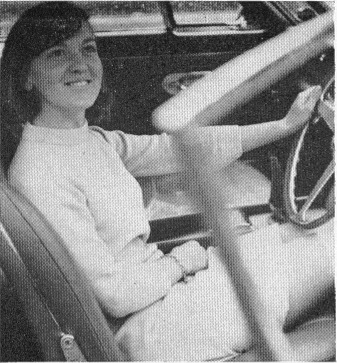 |
| Well, wouldn't you smile? |
Cars and Car Conversions, June 1966 |
|
© Copyright 1966 by Speed and Sports Publications Ltd and IPC Media Ltd |
| Reprinted with permission from IPC Media Ltd |
On the road the fuel consumption is somewhere between 15-17 m.p.g., which means you can go a nice long way before you use up all those twenty gallons. It also means first-class design in the mechanical department, because we can think of 2-litre cars of half the performance which are thirstier than this 4-litre one.
The only snag is a large one: six-and-a-half-thousand pounds’ worth, to be exact, because this is what it would cost you to become the Proud Owner of one of these. The exact total is £6,521 17s. 6d., and of this £1,171 and the odd silver is purchase tax. But on second thoughts, maybe it isn’t so much of a snag. For a start, a price-tag like that means that they tend to be owned by people who appreciate them; if they were cheaper they probably wouldn’t be as good, because you only get what you pay for nowadays. And let’s face it, if they were cheaper there would be more of them around than the sixty or seventy a year which Maranello Concessionaires pass on to lucky customers, and we’d hate to think of Ferraris being as common as Mini-Minors. Wouldn’t you?